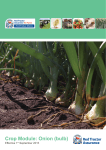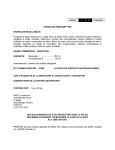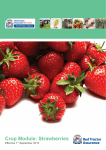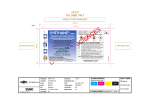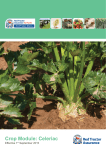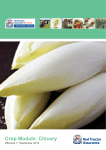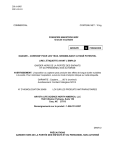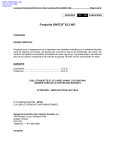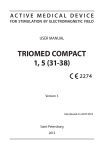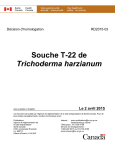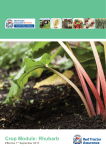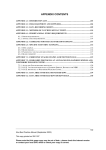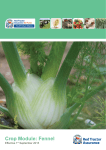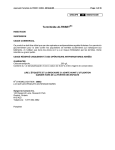Download Crop Module: Parsnips - Red Tractor Assurance
Transcript
Crop Module: Parsnips Effective 1st September 2015 Welcome T his crop specific module for parsnips has been written to complement and avoid duplicating the generic principles of the Red Tractor Farm Assurance Fresh Produce Scheme standards. It is advisable to read the Red Tractor Farm Assurance Fresh Produce standards before reading this crop specific module. This module is designed to stimulate thought in the mind of the reader. It contains crop specific guidance and standards, where applicable, in addition to the requirements stated in the generic Fresh Produce standards. Within this module the important requirements outlined in the crop specific standards section will be verified during the Red Tractor Farm Assurance assessment and compliance will form a part of the certification/approval decision. Disclaimer and trade mark acknowledgement Although every effort has been made to ensure accuracy, Assured Food Standards does not accept any responsibility for errors and omissions. Trade names are only used in this module where use of that specific product is essential. All such products are annotated® and all trademark rights are hereby acknowledged. Notes: Pesticide Information General Introduction Following a systematic approach will help growers identify and manage the risks involved in crop production. This module is based on a typical crop production process and food safety, health & safety, environmental and quality hazards are identified. Appropriate controls may then be established to minimise risk. Food safety and health & safety issues always take precedent over quality and environmental controls. The layout of this module follows the same structure as that used in the Red Tractor Farm Assurance Fresh Produce Standards. The content of the module is reviewed prior to the issue of updated editions. The review process considers both new developments and all relevant technology which has emerged since the last review was completed and which have been found to be both workable by the grower and beneficial to the environment. The aim is to transfer such information and technologies to growers. Acknowledgements Red Tractor Farm Assurance Fresh Produce gratefully acknowledges the contribution of all consultees in the preparation of this protocol, particularly Carey Greenacre from Agronomy and Consultancy Services, Peter Wright from Peter Wright Consultancy Services and members of the British Carrot Growers Association. The Red Tractor Fresh Produce team has been working with Fera to provide tailored access to the LIAISON database for all Red Tractor Fresh Produce members. This system allows individual growers access to all information for plant protection products approved for use under the Red Tractor Fresh Produce Scheme. LIAISON can be accessed under the Produce tab via the “Checkers and Services” page where you will also find a user manual. Searches will be filtered specifically for the crops for which you are registered. Once you have logged onto the site and clicked on the LIAISON hyperlink you will be directed to the LIAISON home screen. You will need a username and password and these will be sent once you have registered: http://assurance.redtractor.org.uk/rtassurance/ services/Registration/members.eb . 1 Red Tractor Assurance for Farms – Crop-specific Module: Parsnips © Assured Food Standards 2015 Content Contents ADDITIONAL REQUIREMENTS AGAINST CURRENT STANDARDS 02 CROP SPECIFIC STANDARDS02 CHOICE OF VARIETY, ROOTSTOCK AND PLANT HEALTH CERTIFICATION03 SITE AND SOIL MANAGEMENT 03 ENVIRONMENTAL PROTECTION AND CONTAMINATION CONTROL04 PEST, DISEASE AND WEED CONTROL 05 NUTRITION10 IRRIGATION 11 HARVEST AND STORAGE 11 RESIDUES AND CONTAMINANTS 13 APPENDIX 1: TYPICAL APPLICATION RATES FOR NUTRIENTS 14 APPENDIX 2: GUIDELINES ON MINIMISING PESTICIDE RESIDUES15 APPENDIX 3: NEMATICIDE APPLICATION PROTOCOL16 ADDITIONAL REQUIREMENTS AGAINST CURRENT STANDARDS None for this crop module STANDARDS IM.b Regular crop inspections must be undertaken and recorded HOW YOU WILL BE MEASURED additional crop specific requirements RECORDS (to be kept for 2 years) n This n Crop includes the field storage period inspection records/diary notes CROP SPECIFIC STANDARDS STANDARDS HOW YOU WILL BE MEASURED RECORDS (to be kept for 2 years) CQ.50.a Fertiliser application must be in accordance with crop need and soil reserves n Prior n Field to cropping field nutrient status is determined by sampling and analysis n nutrient analysis records Analysis is carried out for each field CQ.50.b The washing area must be separated from the packing area so that clean and dirty areas are distinct CQ.50.c There must be a policy in place which details the requirements for cleaning and conserving water used for washing n Washing water cleaning and conservation policy CQ.50.d Waste water disposal must not contaminate watercourses Red Tractor Assurance for Farms – Crop-specific Module: Parsnips © Assured Food Standards 2015 2 GUIDANCE CHOICE OF VARIETY OR ROOTSTOCK AND PLANT HEALTH CERTIFICATION VARIETY SELECTION In choosing varieties of parsnips, due regard should be paid to the following characteristics: n Strength and resistance to bruising. n Tolerance of root and foliar diseases. (Varieties more susceptible to canker and foliar diseases should be avoided.) n Skin and crown quality. n Vigour and habit with relation to their relative programmed use. n Spring “bleeding” of sap. n Seed quality - avoid seed lots with high Itersonilia and Alternaria levels. SITE AND SOIL MANAGEMENT SOIL MANAGEMENT Soil type The choice of a suitable soil is an essential requirement for the production of good quality parsnips. Well-shaped roots will only be obtained if they are able to grow and develop without restriction. Suitable soils are generally sandy in texture and range in lightness from pure blowing sand to sandy loams. Silt soils can produce good quality crops but winter access for harvesting and effective soil separation can be extremely difficult in wet conditions. For this reason the heavier silts should be avoided. Fen soils are not preferred for the production of quality parsnips because of the tendency of organic soils to produce softer roots that are excessively wrinkled and more susceptible to persistent soil diseases. Stones are a common feature of sandy soils; therefore, mechanical stone separation and burying techniques are often needed to minimise root damage and malformation. Soils with a high content of gravel that cannot be machine separated effectively are not suitable for parsnips. Soil pans and soil compaction can lead to impeded drainage, restricted root growth and poor upward flow of moisture through the soil profiles. The use of a soil penetrometer and digging “mini pits” can identify pans and compaction and thus enable remedial action. 3 Crop rotation Crops are rotated to produce a balanced economic and environmental system of farming and to limit the build-up of specific pests, diseases and disorders that adversely affect yield, quality and sustainability. In planning crop rotations for parsnips it is important to recognise that many of the pests and diseases that affect this crop are also encouraged by carrots, celery and umbelliferous herbs such as parsley. Sugar beet and potatoes are also important hosts to Violet Root Rot and free-living nematodes that can seriously affect parsnips and carrots. To avoid further build-up of Violet Root Rot in root crop rotations, the practice of growing sugar beet one year in three or four should be avoided whenever possible. Crop maturing is closely associated with the incidence of disease. Growers should align drilling periods to intended harvest periods so as to minimise the harvesting of over mature roots that undoubtedly degrade more rapidly and increase the soil pathogen inoculum levels. A sound policy of rotation is therefore essential for the future of parsnips and other vegetable and arable root crops. Growing systems Early crops Crops of parsnips for harvesting from late June are grown in specific production areas where irrigation can be used in dry periods. First early crops are seeded in the early autumn/winter and the beds are covered in clear perforated film plastic to warm the soil. The film is removed when seedlings are well developed during April or May. The crop should be encouraged to grow quickly through the application of water and nutrients, thereby avoiding any checks to growth. The drilling population should reflect the variety, seed quality, soil-type, aspect, potential losses and harvest period. In practice, early autumn drilling populations are higher than early spring drillings. Yields reflect both population and market specification. Early crops tend to have significantly lower yields than maincrop drillings. Early over-wintered crops may suffer from frost lift, leading to an increased level of “fanging” (forking) and lateral hairs and therefore marketable quality reduces accordingly. Red Tractor Assurance for Farms – Crop-specific Module: Parsnips © Assured Food Standards 2015 Early crops rarely require protection from carrot fly and foliar diseases and can normally be grown with minimal pesticide input. However, seedling damage caused by springtails (especially Bourletiella hortensis) has been reported in Denmark in early season polythene and fleece covered crops. In areas of the UK where this has occurred, an insecticide seed treatment may need to be considered. All polythene and fleece crop covers used in early production should be recycled wherever possible. Main season and late crops Crops for harvesting from August to April are normally sown during the period February to early June; the later sowings being used for spring lifting. Seed selection and placement is improved by using pelleted seed but it is recognised that graded natural seed establishes more quickly. Options to prime seed are now readily available. This technique can improve crop uniformity and assist in early weed control. Main season crops are exposed to all normal pest and disease pressure during growth and development. Regular inspections combined with trapping and forecasting techniques, are used to guide the crop protection programme. Crops reach marketable size in succession according to variety, drilling date, plant population, site, and management aspects. Foliage dies down in the early winter but unlike carrots, parsnips are not susceptible to damage from the frosts normally experienced in the UK. To achieve continuity of harvesting in frosty conditions some crops are covered in straw, or straw over black polythene, which prevents the soil from freezing around the roots, and also insulates the crop. During the early spring depending on the temperature, crops re-grow strongly producing new foliage and a flowering shoot. As the roots lose condition and become more susceptible to glassiness and spoilage the marketing season naturally ends. This normally occurs during the second part of April except in cooler areas where lifting can be continued for a few further weeks. There should be a satisfactory system of crop monitoring undertaken throughout the field storage period. Following harvest, all plastic materials, including polythene fragments, used as crop covers should be collected and disposed of effectively. Recycling is the preferred option and this route should be investigated before recourse to disposal at registered landfill sites. ENVIRONMENTAL PROTECTION & CONTAMINATION CONTROL THE BASIC APPROACH TO CROP PROTECTION The guiding principle is that pesticide use should be minimised. An integrated approach should be adopted to achieve this involving the following management steps. Planning: a. Sensible crop rotations to avoid build-up of problems b. Careful site selection to avoid potential or previous problems, thereby enhancing crop health and cleanliness c. Inclusion of resistant varieties in cropping programmes whilst retaining the required quality parameters and eating characteristics d. Adopt appropriate target populations to avoid over-sized roots prior to harvest e. Match sowing date with projected harvest date - early sown, late harvested crops are likely to develop a higher incidence of root diseases, particularly canker. Cultural preventative techniques: a. Good crop and field hygiene b. Promoting crop health by ensuring effective nutrient availability through soil analysis and accurate application of fertilisers and trace elements c. Utilising available irrigation to promote healthy growth and to control susceptible pests d. Volunteer carrots and parsnips on un-harvested land and waste ground provide a dangerous source of pests and diseases and should be effectively controlled e. Exploit drilling periods that minimise pest risk f. Consider crop covers to minimise pest attack g. Consider opportunities to control/minimise weed pressure/pest and/or disease pressure within the rotation - prior to parsnip cropping. Red Tractor Assurance for Farms – Crop-specific Module: Parsnips © Assured Food Standards 2015 4 Corrective action Where corrective or protective action is necessary the following approach should be adopted: a. Only purchase seed of an acceptable health standard Carrot fly b. Establish the need to take corrective or protective action by regular monitoring and referring to established thresholds. Consider the effect of prevailing and predicted weather conditions on the need for treatments Carrot Fly is a widely distributed and serious pest of parsnips and treatments for its control account for most of the insecticide applied in this crop. The main problem is larval mining of the swollen taproots, especially in late-lifted crops. The severity of damage increases from November onwards. Seedling emergence coinciding with first generation carrot fly can lead to plant loss where seed treatments are not used. c. Consider the availability and use of cultural, biological and natural methods of pest and disease control d. Where chemical control is essential: n Select the least toxic and persistent product which will provide control with due respect to its efficacy and ecotoxicity. n Use the minimum effective dose or recommended label dose (if reduced rates expose actives to increased risk of resistance development). n Seed treatments should be considered as a first line of defence against seed borne diseases and pests. n Use an appropriate application method with effectively calibrated and maintained equipment. n Use selective appropriate. n Time and spot treatments whenever the treatment accurately. n Formulate an anti-resistant approvals allow. strategy wherever PEST, DISEASE AND WEED CONTROL 5 Where sampling is undertaken and nematicide justified, a reference untreated area should be left to allow evaluation of the guideline threshold that presently exists. The following can be effective in reducing the intensity of attack: i. Do not site new crops adjacent to or following overwintered carrot or parsnip crops. ii. Do not site parsnips next to last years celery crop, as celery is very attractive to carrot fly. iii. Choose large open/exposed fields (>20ha) to grow maincrop and over-wintered crops. iv. Over-wintered crops should avoid small fields (<10ha), sheltered fields with boundaries of trees, hedgerows and nettle beds. v. Separate early and late crops (including carrots, celery and parsley). A separation between late and early crops of 2km or more would be ideal. vi.Harvest early crops and the headlands of storage crops promptly. vii.Aim for a minimum 5-year rotation. PEST CONTROL viii.Lift fields showing signs of larval mining caused by Carrot Fly as soon as possible in order to minimise losses. The incidence of mining damage will increase during the field storage period. Nematodes Carrot fly forecasting and monitoring Soil migratory nematodes are widely distributed in sandy soils and can cause severe economic damage to parsnip crops through direct injury to the seedling taproot causing “fanging” and/or root lesions. For this reason most parsnip crops have been traditionally treated with nematicide at drilling. Other historical reasons for “fanging” include leaching of pesticides, soil compaction, stress caused by wind-blown soil particles at the seedling stage or damage occurred by poor distribution of manure. The HDC-funded carrot fly activity forecast is available by subscription to all levy payers and can give useful guidance on regional root fly activity. Field traps are an effective way of monitoring field specific local activity and are more appropriate to individual circumstances. Both systems combined with local knowledge can be applied usefully to assist in the correct use of carrot fly control measures. Professional help is readily available in setting up trapping schemes and in recording and interpretation of results. Red Tractor Assurance for Farms – Crop-specific Module: Parsnips © Assured Food Standards 2015 Chemical control of first generation It is important to achieve good control of first generation carrot fly as this lessens the incidence of egg laying and subsequent second-generation attack and minimises summer damage. To achieve this, first early (autumn/winter sown under polythene film) crops can be harvested before the carrot fly develops to the root penetration stage, which can occur from early August. On second early (first open sown) crops a spray treatment for first generation control may be required. This should be timed to coincide with adult carrot fly activity. For maincrops, from emergence, during the period of detected first generation carrot fly activity, a timely application of a lambda-cyhalothrin insecticide or Coragen® (active ingredient chlorantraniliprole) will be required to prevent attack to and loss of seedlings. Alternatively, tefluthrin (Force®) seed treatment can be used for crops drilled from mid-March and harvested before mid-August. Earlier use of Force® seed treatment is not effective on carrot fly as the tefluthrin persistence would be inadequate to cover the first generation risk period, traditionally from weeks 15 to 27 (subject to geographical area). However early crops may benefit from protection against other soil pests. The following factors need to be considered in choosing an insecticide for first generation carrot fly control a. The pest spectrum present in the field, e.g. aphids, cutworm. b. The option to adopt tefluthrin seed treatment. c. A full COSHH assessment. Chemical control of second generation Correct timing, particularly of the first treatment of the second generation programme is crucial. This is best determined by carrot fly trapping and may be assisted by the HDC carrot fly forecast. A full programme of treatments is only required for crops grown in high-pressure carrot fly areas. In all other circumstances a reduced programme of treatments should be used. Crops that do not require treatment for second-generation carrot fly, are those harvested before the end of August. In some seasons, the second generation may extend beyond early October, or even a third generation may appear. Commercial experience suggests that NO treatment for carrot fly is justified from mid-October. Recommended application rates and number of applications should not be exceeded. Insecticides are to be applied at the appropriate volume as indicated on respective approvals. Reducing pesticide usage Non-chemical solutions to carrot fly control in the form of crop covers are available and should be considered for evaluation, although cost is likely to limit use. Intensive chemical programmes are not needed where there is little pest activity. Correctly sited and managed orange sticky carrot fly traps will provide individual field guidance on incidence levels. Spray programmes should start only at the beginning of carrot fly activity. Where there is little pest pressure, regular sprays to the outer 24 metres of the crop supplemented with peak activity full field sprays will often provide a satisfactory level of control. Regular monitoring of all crops will provide information that can be used to limit the damage from pest attack. Aphids Parsnips are hosts to Willow-Parsnip and Willow-Carrot aphids, both of which can transmit yellow fleck, mosaic and mottle virus diseases. Migration starts in May to early June to the new season crops. Other aphid species commonly infest parsnips and if they are forming active and damaging colonies, treatments will need to be applied. Aphid warnings Unless aphids are found to be present in crops, aphicide sprays should not be applied. Cutworm Cutworm attacks are common but larval survival and economic damage is mostly confined to light soils and hot, dry seasons. Cutworms may reduce yield on late-drilled crops by severing seedling plants from their taproots but the most serious effect is on the loss of quality caused when cutworm larvae mine into maturing parsnips. Cutworm monitoring It is not practical to monitor turnip moth eggs or juvenile cutworms on foliage as they are just 1.2-1.3mm long when they moult and fall to the ground to burrow into the soil. Monitoring systems for turnip moth (adult cutworm) activity are well developed but turnip moth monitoring alone will not give a guide to the correct spray date that is related to the development of the larvae. Spray warnings are based on dynamic models that will show when sensitive crops should be treated. Red Tractor Assurance for Farms – Crop-specific Module: Parsnips © Assured Food Standards 2015 6 Routine treatment can be unnecessary or wrongly timed. Regularly irrigated crops often do not require treatment. Producers are urged to seek professional advice in this area. Red Spider Mite Infested crops rapidly discolour and hot spots of necrotic leaves become apparent. The Red Spider Mite is a sap feeder and although only just visible to the naked eye is characterised by a fine silky web covering the colony on the leaf under side. Pyrethroid insecticides provide little control and further investigations are necessary to establish appropriate cultural or insecticidal control of this pest. Other pests Chafers, wireworms, silver Y moth, springtails and slugs can all on occasion cause crop damage. DISEASE CONTROL Cultural techniques are essential to avoid build-up of soil-borne diseases and carry-over of pathogens from crop to crop. Seedling diseases Damping-off diseases can reduce plant stand particularly in conditions of adverse emergence. Fungicide seed treatment should be used to limit the development and spread of seed-borne diseases. Effective seed treatments can have a beneficial effect on the reduction of parsnip canker. Seed treatments are a relatively cheap, effective and the most desirable method of control. Seed known to carry a high Alternaria or Itersonilia count should be washed prior to fungicide dressing. Root diseases Black or brown canker Black canker is a relatively common problem of parsnips causing dark brown or purplish-black lesions commonly on the shoulder of the root. The organisms causing such cankers are Itersonilia pastinacae, Phoma spp and Mycocentrospora acerina . Some leaf spotting can also be associated with these diseases. A wide rotation and the choice of more tolerant varieties are useful methods of cultural control. HDC funded research has confirmed that Itersonilia pastinacae is commonly found on commercial seed lots and that seed to plant transmission can occur when the incidence of infection is high. A reduced level of black canker has been correlated with washed seed lots. Differences in varietal tolerances are known. 7 Fusarium spp have also been associated with black scab lesions and rot lesions on the crowns of parsnips. Orange brown canker The cause of orange brown canker has not been fully identified. In common with black canker it is more prevalent in short rotations. Early lesions are small and usually elliptical. The edge of the lesion is often raised and cracked. Eventually the lesions enlarge and darken. This disease /disease complex can affect early and late crops. Cylindrocarpon destructans The soil-borne fungus Cylindrocarpon destructans is generally regarded as a weak pathogen but has been shown to produce black brown canker lesions with orange flecks. They have been frequently found in small reddish brown spots and other small lesions on parsnip roots. Root damage predisposes root invasion by Clyindrocarpon destructans. A number of fungicides approved for parsnip diseases may assist in the control of this disease. Carrot Fly Carrot Fly (Psila rosae) is a major pest of parsnips and badly affected roots have numerous mines and tunnels. These are often reddish brown in colour and may act as sites of secondary fungal attack. Cavity Spot Cavity Spot remains a major problem in many parsnipgrowing areas, particularly in late lifted crops and in wet seasons. Infection pressure appears to increase with frequency of cropping. It can occur on soils not previously cropped with parsnips or related crops, so previous cropping is not an infallible guide to risk. There has been scientific debate as to the exact cause of cavity spot in parsnips but most growers believe it to be the same organisms as cause cavity spot in carrots. Partial control of the main causal organism in carrots (Pythium Violae) is possible with metalaxyl-M applied as a soil fungicide at drilling or within six weeks of sowing. Commercial experience indicates application at 1 true leaf (TL) for optimum efficacy. Growers should remain well informed by referring to any technical literature issued by the crop protection product manufacturer and/ or latest research when using Metalaxyl M. A soil ELISA test can provide an indication of site cavity spot risk, both before and during the growing season. This test is available commercially and producers are urged to continue to evaluate the usefulness of this test in their own circumstances and to monitor and record the incidence and control of cavity spot in fields in which the soil test has been used. Red Tractor Assurance for Farms – Crop-specific Module: Parsnips © Assured Food Standards 2015 The incidence of cavity spot can increase in lower pH soils, on land recently manured, in wet growing seasons and in over-mature crops. Work carried out at HRI Wellesbourne suggested that free Ca2+, applied at drilling, significantly reduces the incidence of cavity spot. This has not been fully validated and growers should be aware that any calcium product that increases localised soil pH will also increase the risk of scab! FOLIAR DISEASES developing specifically lead to the cavity spot Downy Mildew (Plasmorpara nivea) Downy mildew occurs much more spasmodically than powdery mildew but can cause extensive yellowing and necrosis of the leaves. Symptoms of the two diseases may be confused but downy mildew generally first develops on the underside of the leaf and causes yellowing of the upper surface in more angular patches delimited by veins in the leaf. The white fungal growth is composed of numerous erect spore stalks, which collapse under dry conditions. The yellow blotches turn brown with age and hasten death of the foliage. Rhizoctonia (Rhizoctonia solani) Rhizoctonia solani occurs in most soils and appear to be capable of causing coarse black scarring especially on the crown of the root. Incubation of affected roots in a moist chamber quickly reveals mycelial growth of Rhizoctonia solani. Small warty patches on the crown or sides of the root may be caused by scab as in other root crops. Parsnip roots may also carry sclerotia (resting bodies) of Rhizoctonia solani, identical to black scurf on potatoes and other root crops. The black scurfis superficial and can be scraped off, but may resist normal root washing procedures. Rhizoctonia also produces spores on a characteristic white collar on the petioles just above soil level though this phase does not cause rotting of the underlying tissue. Phoma Conspicuous pale or reddish brown spots with a deep purple margin are likely to be caused by Phomopsis diachenii. A scattering of small black fruiting bodies (pycnidia) are often distinguishable within the leaf spots. Whilst Phomopsis has not been of economic importance to date, there is increasing concern about the closely related Phoma leaf spot (Phoma complanata), which has caused severe foliar damage particularly in North America. Phoma initially causes small brown spots up to 1mm in diameter, which have yellow haloes. Foliage blight develops if the spots start to merge. Brown spots on the petiole darken with age and cause characteristic crooking over of the leaves. Leaf symptoms have not been prominent in the UK but may be overlooked, as Phoma root cankers are common. The British Carrot Growers Association is a Research and Development strategy for cavity spot. It is expected that this will production of “best practice guidelines” for management in the future. Splitting and “Fanging” (Forking) Splitting of the periderm or cracking because of uneven growing conditions can lead to substantial increases in fungal attack. Varietal differences have been noted. “Fanging” symptoms may be due to pest, disease or soil factors. The relative importance of these factors varies from site to site, as does the distribution of the problem in the field. It is generally agreed that symptoms of secondary root proliferation are due to damage to the taproot at the seedling stage. Violet root rot (Helicobasidium purpureum) Avoidance of sites where there is any history of this disease is the only control measure currently available. Carrots and many arable root crops are also susceptible. Common scab (Streptomyces scabies) Scab is less common on parsnips compared to carrots but it can occur on parsnips grown on coarse sandy soils of high pH. It can also occur on other soil types in seasons when the early summer period is dry. The root appears susceptible to infection at the seedling stage and well-timed light irrigation can provide some control. Scab lesions darken and enlarge with age and can become infected with secondary bacteria and fungi. Severe scab causes wastage and should be avoided. Powdery mildew (Erisyphe heraclei) Powdery mildew is the most common foliar disease of parsnips. Yield may be reduced following early severe attack. Fungicides are best applied at the first sign of mildew attack when lesions can be clearly identified in the lower foliage and often on the petiole. Repeat treatments may be necessary on late crops. Maintaining good plant health and vigour with the avoidance of moisture stress will provide partial control. Routine fungicide treatments are not usually necessary and should be avoided if possible. Varieties differ in their tolerance. Sclerotinia (Sclerotinia sclerotiorum) Sclerotinia will attack parsnip foliage and can progress into the crown of the root to cause a root rot. Decaying leaf tissue provides the food source for Sclerotinia. Aim to maintain healthy foliage. Crops which have very vigorous foliage are the most susceptible to attack. Select varieties with strong, upright foliage to increase the airflow through the canopy. Avoidance of conditions, which lead to excessive foliage growth, will limit the incidence of Sclerotinia. Manage irrigation carefully and avoid over-irrigation. Red Tractor Assurance for Farms – Crop-specific Module: Parsnips © Assured Food Standards 2015 8 Results from crop monitoring systems for the germination of Sclerotinia are now readily available in some areas of the country which provides information for growers on disease risk. Leaf spot (Ramularia pastinacae) Leaf spot caused by Ramularia pastinacae is common in wetter seasons in parsnips. Unless significant leaf attack is present control measures are not justified. No fungicides are specifically approved for the control of Ramularia. Phleospora heraclei This disease has occurred sporadically in East Anglia. The disease tends to be localised initially and can then spread rapidly through the field. The disease is typified by small white spots occurring on the leaves, which become shot holed with leaf death occurring shortly after. Young actively growing leaves tend to be attacked first, making this disease particularly destructive. Parsnip Yellow Fleck Virus The parsnip yellow fleck virus is spread by aphid activity within the crop. Infestations are spread sporadically throughout the field. Infected plants have mottled, yellow-flecked or pure yellow leaves, often twisted and stunted. Unlike carrots, attack does not normally lead to plant death. With the loss of O.P. insecticides aphids are more commonly colonising in crops and therefore routine field inspections and prompt treatment are essential. Other leaf disorders caused by diseases, pest, etc. Two of the fungi responsible for black cankers are also capable of causing foliar symptoms. Itersonilia pastinacae can cause small pale green or water-soaked flecks, which may have a paler halo. These flecks turn brown and merge to give more general leaf necrosis. Mycocentrospora acerina is capable of producing water-soaked or necrotic lesions on parsnips and many other host plant species. Virus diseases can often be found in parsnips on occasional scattered plants and foliar symptoms are consistent with their names - e.g. parsnip mosaic virus. Fine yellow or brown speckling of leaves caused by the two-spotted mite (Tetranychus urticae) has been a feature of some crops in recent hot dry summers. Webbing and signs of the mites themselves will be found on the underside of affected leaves. The sudden appearance of scorch or necrotic spotting symptoms on the margins of younger leaves in hot weather may be attributable to spray scorch. Similarly, scorch on the edges of leaves may be attributable to wind damage, either directly or as a result of wind-blown soil particles. 9 The use of late application fungicides against foliar dieases can prolong the leaf canopy and provide early frost protection to the soil allowing for more winter acreage to be lifted in freezing conditions. WEED CONTROL Weed incidence is determined by land use, crop rotation and recent weed control strategies and as such can vary significantly within short distances between farms, regions and across the country. Following the loss of a number of previously important herbicides as a result of the Pesticide Review growers are encouraged to adopt and perfect more cultural methods of weed control, to include timely inter-row cultivation and use of selective herbicide treatments where possible. A balance between herbicide efficacy and persistence should be considered. Repeat low-dose programs and tank mixes are often necessary in order to cover the complete weed spectrum. Later drillings may have the opportunity (depending on soil type and weather) to adopt stale seedbed techniques to minimise the weed pressure. This is particularly effective for the control of fools parsley and mignonette. Perennial weeds should be controlled prior to drilling. With the recent development of sophisticated hoes, mechanical weeding is not only an option but has a definite place within parsnip weed control strategies. From the 5 TL stage parsnips become highly competitive and their foliage can smother late-germinating weeds. Hoeing is often beneficial just prior to crop canopy closure. In some fields where groundsel has been inadequately controlled by herbicides, mechanical hoeing may be the only way to clean up the crop. Certain weeds are so closely related to parsnips that selective chemical control is impossible. Examples such as hemlock and wild carrot can be particularly problematic and should be avoided. Fields containing significant proportions of these weeds should not be cropped with early polythene-covered parsnips, as mechanical control methods are not possible while the crop is covered. All such weeds emerging through the crop and producing viable flowering shoots should be machine topped, weed wiped or hand pulled to prevent the production of seed and further contamination. Red Tractor Assurance for Farms – Crop-specific Module: Parsnips © Assured Food Standards 2015 Where weed pressure is low but the species present are important (.e.g. volunteer potatoes) hand weeding or weed wiping should be considered as a priority over overall spray applications. Where the weeds present occupy distinct areas of the field or the sides of the beds, only selective or directed treatment is necessary. Parsnips are generally grown on soils prone to leaching therefore care should be taken that no herbicides appear as major pollutants of ground water. APPROVED USES NOT INCLUDED ON THE PRODUCT LABEL In many circumstances, particularly for minor crops, product labels do not include all of the approved uses and growers wishing to check the approval notice of a particular product should note that this information is available using the LIAISON® search accessible via their RED TRACTOR Farm Assurance home page after logging in. A search on the ‘Specific Off-Label Approvals’ page of LIAISON® by crop or product name should yield a results page. A click on the product name should link to a summary of the approval information. Near the bottom of the summary is the specific off-label number (e.g. 0246/09) and this link will open up a pdf of the current SOLA (now called Extension of Authorisation for Minor Use (EAMU)) document giving details of the extension of use. NUTRITION MAJOR NUTRIENTS Prior to cropping, the field nutrient status should be determined by sampling and analysis. Analysis is required for each field, as fertiliser application must be in accordance with crop need and soil reserves. Phosphate, potash and magnesium blended base fertiliser is normally applied as a soil treatment prior to ploughing, stone separation or bed making. Where dressings of potash exceed 150kg/ha, the remainder is best applied as a top dressing at 2 - 4 true leaves. a. Almost all parsnip production areas are within the revised Nitrate Vulnerable Zones (NVZ) published. Parsnips are relatively low N users but it is nevertheless important that nitrogen applied is in accordance with crop requirements and large single or excess applications are avoided. b. Growers are encouraged to more fully understand crop off-take on their soil types so as to provide evidence in support of total nitrogen applied. Trace elements Many sandy soils, particularly where the pH is high, are deficient in trace elements. Deficiencies of manganese and copper are common and are best corrected using specific inorganic trace element foliar sprays. For boron application it is appropriate to apply a boronated base fertiliser and/or foliar spray to correct this. Base Boron applications are not suitable on high pH soils. Parsnips are less susceptible to boron deficiency than carrots. The crop nutrient status can be readily checked during growth using leaf analysis. This can be a useful guide to the need or otherwise of trace element treatments. Where trace element and multi-nutrient foliar feeds are used routinely, it is appropriate to demonstrate that such treatments are justified through tissue or other appropriate analysis. All unnecessary fertiliser and trace element treatments should be identified and avoided. Where the soil pH is low (5.8 or below) it will be necessary to apply a liming material in accordance with established practice (RB209). Examples of typical fertiliser recommendations may be found in Appendix 1. Red Tractor Assurance for Farms – Crop-specific Module: Parsnips © Assured Food Standards 2015 10 IRRIGATION Irrigation response Adequate soil moisture at seed depth is essential to give satisfactory plant establishment. Conservation of moisture during land preparation and at drilling is essential. Irrigation, as an aid in crop establishment, has proven very beneficial in dry spring conditions. Accurate timing of irrigation for establishment is essential. Many of the soils used for parsnip production have low levels of available water. Parsnip roots penetrate deep into the sub-soil and therefore are regarded as very drought tolerant crops. It should, however, be recognised that soil type and irrigation strategy have a direct effect on skin quality. Heavier soils, or soils under moisture stress, will often have more wrinkled, cream-coloured skin. The development of earlier crops may be promoted by regular irrigation. Summer crops require regular irrigation to maintain crop continuity and skin quality. Irrigation scheduling Scheduling systems help forecast the timing of irrigation and the priority order. A field inspection to examine the soil profile is essential to confirm when the profile is becoming dry and to check on the success of applied irrigation. Capacitance/neutron probes and other soil moisture sensor techniques that give a direct measure of soil water are available and their use is encouraged to maximise irrigation efficiency. Irrigation water is a scarce resource and it should only be applied in accordance with need. HARVEST AND STORAGE HARVESTING Parsnip roots are very susceptible to mechanical damage and care is needed to ensure that damage is minimised during harvesting and preparation for market. Roots soon discolour and are difficult to wash clean if there is undue delay between lifting and washing, although the introduction of ‘polishing’ washers allows some additional retention time. The process of browning is related to temperature and in the summer in particular a few hours delay is sufficient to cause a considerable loss of whiteness and quality. Share lifting is used in preference to top lifting so as to minimise crop damage. Every effort should be made to minimise damage whilst avoiding the transportation of excessive soil to the washer. For these reasons 11 there is now an increasing interest in positive selection harvesters that displace soil and allow hand selection of quality crop, the residue falling back on the field. Measures should be taken to avoid deterioration and damage of the product during harvesting, washing and storage. Food business establishments should be registered with the local Environmental Health Department (Regulation No. EC 852/2004 Hygiene of Foodstuffs). POST-HARVEST WASHING Washing The crop is fresh washed as it is inclined to discolour if held for more than a few hours before washing. If holding is essential then raw material should be kept cool and moist. The introduction of ‘polishing’ washers has allowed some leeway on the retention time of unwashed parsnips. It is essential that the washing area allows an efficient and rapid throughput of raw material in order to maintain quality in the final product. The washing area must be separated from the packing area so that clean and dirty areas are distinct. All equipment should be well designed and manufactured for minimal damage and ease of cleaning. An efficient in-line hydro cooler will remove much of the field heat and assist in the preservation of freshness and colour. Parsnips are commonly size graded over diverging or drop roller graders. The larger grades are presented loose and the smaller sizes are tray and pre-packed. All roots to be marketed should be inspected on a well-lit belt or roller table where defective roots can be removed from the sample. Roots meeting customer’s requirements are often trimmed to length before packing. Knives should be plastic handled with a stainless steel blade and stored safely in a sterilising solution when not in use. Water supply Water can be drawn from any source providing its quality is satisfactory under the Private Water Supply Regulations, 2009. Microbiologists can advise on suitability and treatment of water supplies. Routine checking of non-mains supplies should be carried out. A final rinse with clean water is essential. Efficient soil extraction on harvesters and at the washer intake will reduce the volume of wash water required and help conserve supplies. Red Tractor Assurance for Farms – Crop-specific Module: Parsnips © Assured Food Standards 2015 Waste water disposal Disposal systems should cope with: a. the volume of liquid waste and its fluctuation, b. the quantity of solids therein, c. the polluting nature of dissolved organic matter. Large seasonal and day-to-day variations of water quantities for disposal are normal. Adequate provision should be allowed for these and rainfall. There are statutory powers to prevent the pollution of underground water by discharge of effluent. Underground pollution can be traced to land used for disposal of solid or liquid wastes and great care is needed to prevent this. Pollution of streams and water supplies derived from wells, springs and boreholes can lead to action by the local water authority (Environment Agency/ water Company). Screening and sedimentation are two recommended methods of separating solids from water. Every discharge (except clean roof water), reaching certain tidal and all non-tidal rivers requires the prior approval of the Environment Agency. The burning of parsnip straw may be permitted but any grower considering this method of disposal needs to consult the following websites and take appropriate advice: http://www.environment-agency.gov.uk/business/ topics/permitting/116165.aspx http://www.environment-agency.gov.uk/business/ topics/permitting/116330.aspx http://www.environment-agency.gov.uk/business/ topics/permitting/default.aspx http://www.netregs.gov.uk/netregs/businesses/ agriculture/default.aspx (this takes you to links for Scotland and Northern Ireland http://www.environment-agency.gov.uk/business/ default.aspx (this takes you to links for England and Wales). The following minimum legislation should also be observed: (other guidelines or legislation may also apply): The Clean Air Act 1993 (dark smoke) The Health and Safety at Work Act 1974 (worker safety) Waste solids disposal Waste vegetable material and soil often carries significant levels of persistent pests and diseases. It is essential, therefore, that solid pack-house and washer waste is not returned to land that is likely to be cropped with root crops. Water recycling Effective screening, sedimentation and storage are required where water is to be re-used for washing. Reclamation is likely to require a chlorinating plant. There must be an adequate cleaning and conservation policy for water used for washing. STORAGE Strawing Straw covering enables crops to be lifted when open soil is frozen but is an expensive technique and it requires large amounts of energy to bale, move, spread and dispose of straw residues. Straw disposal can be a major problem. For effective incorporation, straw should be thoroughly chopped and premixed before ploughing in. Coincident removal and chopping can reduce subsequent energy requirement for incorporation. Modern straw removing machines are available which disperse the straw uniformly to the adjacent field area. The Highways Act 1980 (1986) (safety of road users) The Environmental Protection Act 1990 (statutory nuisance) Burning is only partially effective and a potential nuisance and the trend is towards its avoidance through improved mixing techniques. Incorporated straw, as it breaks down, can provide useful, short term soil conditioning improvements and contribute to organic matter build-up in the soil. Polythene and straw Crops covered with a substantial layer of straw, sometimes underlain with black polythene, remain dormant for longer than open crops and help extend the marketing season. Unlike carrots, parsnip spring re-growth is not light dependent and the use of black polythene may hinder harvesting of very late season crops, as the parsnip foliage can grow through the polythene. Strawing-down + black polythene is the standard storage technique in the UK of parsnip crops for winter and spring lifting. Following lifting, all polythene fragments should be collected and disposed of effectively. Recycling is the preferred option and this route should be investigated before recourse to burial at registered landfill sites. Red Tractor Assurance for Farms – Crop-specific Module: Parsnips © Assured Food Standards 2015 12 Cool storage RESIDUES AND CONTAMINANTS There is very limited information on long-term cool storage for the UK but it has been practiced on the continent to a small degree. Minimising root damage and abrasion during harvesting and storage is essential. Soil type, root health and maturity, harvest temperature, cooling stage and storage temperature and humidity also affect ability of the crop to store long-term. Particular attention should be given to the hygiene of wooden storage boxes used for parsnip cool storage as some fungal pathogens are known to be able to colonise wooden surfaces and cause disease on parsnips. Red Tractor Farm Assurance Fresh Produce is aware that a key area in the production of fresh produce which requires continued attention by growers and their advisers is that of keeping pesticide residues to a minimum. The issue is not just one of meeting the MRL trading standard but ensuring that any individual or multi residues are kept as low as possible below this level. Maleic hydrazide The growth regulator maleic hydrazide, applied to the crop in the autumn, prior to winter storage is recognised within the industry as a cost effective management tool for extending the winter storage season in terms of crop quality. Use of this product can also enable a reduction in the quantity of straw applied for spring harvested main-crop parsnips, the use of which, together with black polythene, is predominantly to maintain crown quality and provide protection against pests such as rabbits, hares and deer. The key targets are: n Utilising combinations of pre-emergent herbicides. n Optimising all application of fungicides to the edible part of the crop n Ensuring minimum harvest intervals are followed n Ensuring that application equipment is applying products correctly See appendix for the pesticide targets and guidelines for this crop. The use of fungicides to maintain green leaf into the autumn can aid Maleic Hydrazide application decisions, and give more even uptake of the sprout suppressant. Not all retailers or processors permit the use of maleic hydrazide on parsnips and the grower needs to confirm acceptability from his customers before use. 13 Red Tractor Assurance for Farms – Crop-specific Module: Parsnips © Assured Food Standards 2015 APPENDIX 1: TYPICAL APPLICATION RATES FOR NUTRIENTS (KG/HA) Major nutrient requirements (kg/ha). Extracted from Fertiliser Manual (RB209) 8th Edition Nutrient (kg/ha) Soil Index P, K, Mg or SNS level 0 1 2 3 4 5 6 Nitrogen (N) all soils 170 130 100 70 20 0a 0a Phosphate(P2O5) (2) 200 150 100 50 0 0 0 Potash (K2O) 300 250 200(2-) 150(2+) 0 0 0 Magnesium (MgO) 150 100 0 0 0 0 0 a) A small amount of nitrogen may be needed if SMN levels are low in the 0-30cm of soil Nitrogen – Apply no more than 100kg/ha N in the seedbed. The remainder should be applied as a top dressing when the crop is fully established. Copies of various publications on parsnip productions are available to levy payers from: Horticultural Development Company, Stoneleigh Park Kenilworth, Warwickshire, CV8 2TL. Tel: 0247 669 2051 Web: www.hdc.org.uk Free publications can be ordered by telephone or by e-mail to [email protected] . Most reports are downloadable from the website at www.hdc.org.uk Red Tractor Assurance for Farms – Crop-specific Module: Parsnips © Assured Food Standards 2015 14 APPENDIX 2: GUIDELINES ON MINIMISING PESTICIDE RESIDUES These guidelines have been produced after consultation between crop stakeholders and the Fresh Produce crop author. They will be developed over the coming seasons as knowledge on minimising residues develops. Growers should consult with their crop protection adviser to ensure other best practices are not compromised before considering these guidelines. The table below lists the active ingredients that may give rise to crop residues and details alternative strategies. The author’s review of historical and potential pesticide residues in parsnips identified a low risk of residue. The active ingredients that can leave detectable residues (all consistently below the MRLs) are pendimethalin, azoxystrobin, iprodione, tebuconazole,difenconozole, fenpropimorph, linuron, tefluthrin and boscalid. These values may be further reduced through closer attention to: operator training; sprayer maintenance; calibration; and increasing respective harvest intervals etc. In the short term, in consideration of the fungicides, growers may also wish to consider: adopting disease free seed; improved fungicide timings with disease prediction; fungicide mixes to allow reduced rates and cultural controls (i.e. choosing varieties with disease tolerances and erect foliage, reviewing row configurations, matching drilling timings with populations to minimise over maturity, and closer nitrogen and irrigation management). The loss of a number of herbicides at the end of 2007 makes reduced rate usage of pendimethalin less of an option. Active ingredient Target: pest, weed, disease Suggested guidelines pendimethalin Pre-emergent weeds Use less than maximum rate and utilise additional pre-emergent herbicides in the tank mix linuron Broadleaf weeds Use less than maximum rate and utilise additional herbicides in the tank mix tefluthrin Carrot Fly Do not treat seed for sowing before mid-March Minimise exposure to seed borne Alternaria azoxystrobin iprodione fenpropimorph tebuconazole Alternaria, powdery Adopt Alternaria resistant varieties mildew Improve fungicide timing by adopting disease prediction (Decision Support Systems) and/or crop monitoring aids Alternaria, powdery mildew, canker Alternaria, powdery mildew, crown rot Powdery mildew difenoconozole Fungal pathogens As above As above Use this product early in a fungicide crop protection programme Use this product early in a fungicide crop protection programme Use this product early in a fungicide crop protection programme Adopt fungicide mixtures to reduce rates of higher-risk actives boscalid Sclerotinia Modify husbandry to minimise disease risk: Review row configurations Match variety, drilling and harvest period to minimise over- maturity Closer management of nitrogen to avoid excessive foliage development Closer management of irrigation to avoid excessive foliage development Maximise rotation interval 15 Red Tractor Assurance for Farms – Crop-specific Module: Parsnips © Assured Food Standards 2015 APPENDIX 3: NEMATICIDE APPLICATION PROTOCOL Nematicide Application Protocol (Code of good practice for the application of nematicides) Professional advice Growers should always seek advice from a BASIS qualified agronomist prior to the purchase and use of a nematicide. Recommendation sheets should be available for each treated field. Operator requirements Operators have to be qualified to apply nematicides (NPTC PA4 or PA4G certification). By March 2017 staff applying nematicides must have completed the Industry Stewardship Training module. Machinery details Growers should be able to demonstrate that the granule applicator has been calibrated and has been inspected and certified annually by NSTS. Rotors or cassettes the nematicide. should be appropriate for When applying nematicide growers should keep records to demonstrate that: n The applicator is checked prior to each work day, ensuring all pipework is correctly fitted, the hopper bungs are in place and the hopper lids are secure. n The applicator is calibrated each week. Growers should use a single site for filling hoppers in each field, which can easily be checked for spillages. Small spillages should be buried immediately ensuring no granules are left on the surface. In the case of a larger spillage growers should put emergency procedures in place and make sure those dealing with the spillage wear appropriate PPE, as stated on the product label. Ensure operators have appropriate emergency equipment such as spill kit and decontamination equipment for skin and eyes, emergency details for the products being used; and a list of emergency contact details for the environment agencies and medical services. Transfer the granules to the original container or an empty container that originally held the same product. The container should be in good condition and with an undamaged label. Access the container by removing the valve and undoing the clamp (or tie seals) around the neck. If an original product container is not available, transfer the spilled granules into a suitable, larger container clearly labelled with the product name and the hazard classification and risk and safety phrases shown on the product label. Operator exposure Operators are required to use correct PPE in line with product labels and COSHH A stable filling platform should be available for safe lifting and emptying of the nematicide containers n The Operators and field supervisors should be aware of the procedures required in the case of an accidental exposure to a member of staff. Protecting the environment – preventing granule spills Post Application wildlife monitoring Nematicides should be applied and incorporated within a single pass. Applicators with a working width wider than the rotavator should not be used. Growers should check treated fields 24 hours post application for any bird or animal carcasses. Any carcasses found may indicate poor incorporation of granules. If granules are seen on the surface they should be incorporated immediately. Remove and cover the carcass, then contact the Wildlife Incident and Investigation Scheme (WIIS) using the UK free-phone number 0800 321600. Also contact the granule manufacturer: area treated and the product volume used match for each field. By March 2017 all applicators must be fitted with a device in cab that allows the operator to shut off nematicide granule flow at least 3 meters from the end of each row. For those applicators fitted with a hydraulic or electric motor this should already be possible. For those applicators driven by a land or spider wheel an electronic clutch can be fitted to the applicator drive shaft to enable remote shut off. [http://www.cropsprayers.com/Horstine/] After planting growers should rotavate headlands to ensure no granules left on the soil surface. Vydate call DuPont 01438 734450 Nemathorin call Syngenta 0800 1696058 Mocap call Certis 01223 894261 Red Tractor Assurance for Farms – Crop-specific Module: Parsnips © Assured Food Standards 2015 16 NOTES 17 Red Tractor Assurance for Farms – Crop-specific Module: Parsnips © Assured Food Standards 2015 Certification Bodies Your routine point of contact with the Scheme is through your Certification Body. Certification Bodies are licensed by Red Tractor to manage membership applications and to carry out assessment and certification against the Standards. The table below shows which Certification Bodies apply to each enterprise. Certification Body NSF Kiwa PAI SAI Global SFQC Beef and Lamb Dairy Combinable Crops and Sugar Beet Fresh Produce 4 4 4 4 4 4 4 4 4 4 4 4 4 4 4 4 NIFCC (Northern Ireland) 4 QWFC (Wales) 4 Pigs Poultry 4 4 4 4 4 4 4 NSF Certification Kiwa PAI Hanborough Business Park Long Hanborough Oxford OX29 8SJ Tel: 01993 885739 Email: [email protected] Web: www.nsf-foodeurope.com The Inspire, Hornbeam Square West, Harrogate, North Yorkshire HG2 8PA Tel: 01423 878878 Email: [email protected] Web: www.kiwa.co.uk/pai SAI Global Assurance Services Ltd PO Box 6236, Milton Keynes MK1 9ES Tel: 01908 249973 Email: [email protected] Web: www.saiglobal.com/assurance QWFC SFQC Ltd NIFCC [Northern Ireland] QWFC [Wales] Royal Highland Centre, 10th Avenue, Ingliston, Edinburgh EH28 8NF Tel: 0131 335 6605 Email: [email protected] Web: www.sfqc.co.uk Lissue House, 31 Ballinderry Rd, Lisburn, Northern Ireland BT28 2SL Tel: 028 9263 3017 Email: [email protected] Web: www.nifcc.co.uk PO Box 8, Gorseland, North Road Aberystwyth SY23 2WB Tel: 01970 636688 Email: [email protected] Web: www.wlbp.co.uk T: 01932 589 800 E: [email protected] www.redtractorassurance.org.uk Fresh Produce Standards





















